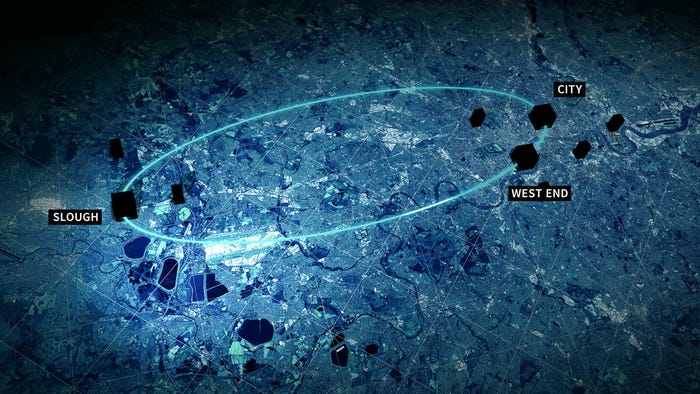EY paraded as the first customer of what is described as a three-year commercial trial.

BT, in partnership with longstanding quantum tech buddy Toshiba, has launched what it calls the world's first "commercial trial" of a quantum-secured metro network (QSMN).
The QSMN is a three-node London exchange ring using commercially available QKD (quantum key distribution) hardware from the Japanese supplier. BT provides fiber connectivity and "quantum-enabled" local exchanges.
German vendor ADVA is also in the QSMN mix. For the dedicated QKD "access tails," BT uses a commercially available Optical Spectrum Access Filter Connect (OSA FC) solution from Openreach, the UK incumbent's infrastructure arm. OSA FC was developed by ADVA.
Figure 1:  The QSMN is a three-node London exchange ring using commercially available QKD (quantum key distribution) hardware from Toshiba with BT providing fiber connectivity and “quantum-enabled” local exchanges.
The QSMN is a three-node London exchange ring using commercially available QKD (quantum key distribution) hardware from Toshiba with BT providing fiber connectivity and “quantum-enabled” local exchanges.
(Source: BT)
Access tails are needed by customers to connect their sites to the QSMN, where QKD key distribution is done on the same fiber carrying data. They are also needed to egress the QSMN and direct secure traffic to its intended destination. Access tails, said BT, can be up to 30 km long.
The upshot is an "end-to-end" QKD-fiber link that is secure against attacks from powerful quantum computers in the future, which may have the potential to crack today's public key cryptography systems within hours or minutes – the so-called quantum apocalypse. Experts reckon traditional computers would take millions of years to unscramble current communications cryptography.
Getting down to quantum business
EY, a financial services company, was paraded by BT and Toshiba as QSMN's first "customer." The company is using QSMN to connect two of its sites in London with 10Gbit/s access tails.
EY is not a paying customer, of course. It hardly needs to be given that the quantum computing threat has not yet arrived. BT is rather working with EY – and other customers when they get onboarded to QSMN – to work out, over a three-year period, which types of QKD services will be in demand and how the business case might pan out.
"It's a commercial trial in the sense that it's built on commercial kit," Professor Tim Whitley, managing director at BT's applied research division, told Light Reading.
"It's also a commercial trial in the sense that, unlike many trials around, it is effectively integrated in and part of a national operator's communications infrastructure. It is managed out of our national operations center at Adastral Park."
Andrew Lord, senior manager of optical research at BT, added it was far too early to think about generating QKD-based revenue.
"There's still the question of defining services," he said.
"What will we sell and how will it be consumed? Do customers want secure access into a data center, for example? Or is it a secure Ethernet pipe into premises? Would they like the keys to encrypt a secure application? Do customers want access to Layer 3. I can list a whole load of potential services, but I still don't know which ones [will be required]."
It ain't point-to-point
BT and Toshiba have been conducting QKD trials since 2013, including a recent collaboration to provide a point-to-point QKD link in Bristol between the National Composites Centre and the Centre for Modelling & Simulation.
Lord emphasized, however, that QSMN is a "network" as opposed to the point-to-point approach, which can't scale without consuming huge amounts of resources. While a shared core infrastructure is more economical, Lord nonetheless pointed out that it brings its own problems.
"You have to make sure that keys from one customer get to the right place," he said.
Since last September, when BT and Toshiba started working on QSMN in earnest, Lord says this was one of the hardest problems to solve and took "weeks of discussion." The eventual solution was Toshiba's key management system (KMS), which Lord singled out for praise in his presentation.
"[QSMN] is not a physics breakthrough, but it is in terms of network science," he told Light Reading.
"It's something we've never done before."
Quantum apocalypse (not now)
Given BT intends to spend three years on the QSMN commercial trial, and that BT CTO Howard Watson cited in his presentation some estimates that quantum-enabled security attacks could be possible within the next five years, Light Reading asked if BT and industry were moving fast enough on rolling out quantum-secured communications.
Want to know more? Sign up to get our dedicated newsletters direct to
your inbox
Watson indicated that BT was well placed to meet the threat.
"The QSMN is built on standard fiber and COTS hardware," he said. "We could start to build a national [QKD] network from this now, but there's no market demand yet."
Related posts:
— Ken Wieland, contributing editor, special to Light Reading
Read more about:
EuropeAbout the Author(s)
You May Also Like










